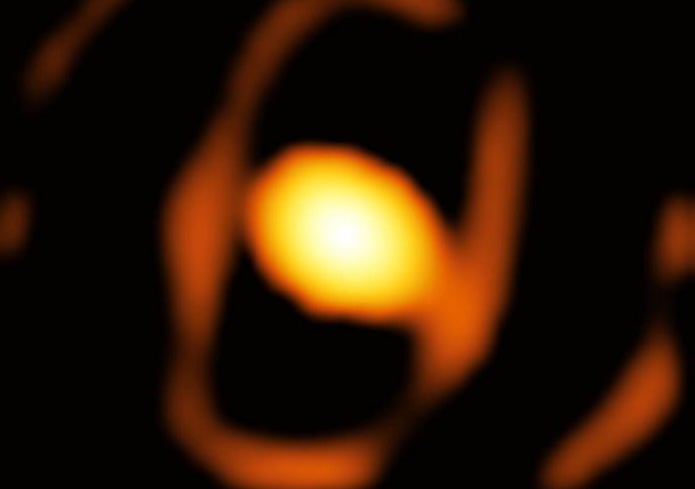Scientists take first ever close-up picture of star outside our galaxy – and see strange structure around it
Image shows stars in its death throes – though wrapped in a huge cocoon

Your support helps us to tell the story
From reproductive rights to climate change to Big Tech, The Independent is on the ground when the story is developing. Whether it's investigating the financials of Elon Musk's pro-Trump PAC or producing our latest documentary, 'The A Word', which shines a light on the American women fighting for reproductive rights, we know how important it is to parse out the facts from the messaging.
At such a critical moment in US history, we need reporters on the ground. Your donation allows us to keep sending journalists to speak to both sides of the story.
The Independent is trusted by Americans across the entire political spectrum. And unlike many other quality news outlets, we choose not to lock Americans out of our reporting and analysis with paywalls. We believe quality journalism should be available to everyone, paid for by those who can afford it.
Your support makes all the difference.The first ever close-up picture of a star outside of our galaxy has shown that it is wrapped in a strange structure.
The image shows a star named WOH G64 that is surrounded by gas and dust. The picture shows its final death throes, and it will soon die in a huge explosion known as a supernova.
It not only marks the first image of this kind of a star outside of our galaxy, but also the first time scientists have been able to see the pivotal events in the death of a star like this.
The dying star is located about 160,000 light-years from Earth, in a neighbouring galaxy called the Large Magellanic Cloud.
It is the first zoomed-in image of a mature star in another galaxy, though a stellar newborn in the Large Magellanic Cloud was spotted in research published last year. Zoomed-in means the image captures the star and its immediate surroundings.
The image, somewhat fuzzy, was obtained using the European Southern Observatory’s Chile-based Very Large Telescope Interferometer. It shows the star surrounded by a glowing egg-shaped cocoon of gas and dust - called a nebula - apparently ejected by the star. A faint oval ring beyond the cocoon, perhaps made of more dust, is also seen.
“The star is in the last stage of its life before a stellar demise,” said astronomer Keiichi Ohnaka of Universidad Andrés Bello in Chile, lead author of the study published on Thursday in the journal Astronomy & Astrophysics.
“The reason we see these shapes is that the star is ejecting more material in some directions than in other directions. Otherwise, the structures would look spherical,” Ohnaka said.
Another possible explanation for these shapes is the gravitational influence of an as-yet undetected companion star, Ohnaka said.
Before it started to blow off material, WOH G64 was estimated at about 25 to 40 times the mass of the sun, according to astronomer and study co-author Jacco van Loon of Keele University in England. It is a type of massive star called a red supergiant.
“Its estimated mass means it has lived for about 10 to 20 million years, and will soon die,” van Loon said.
This represents the first image of a star “in this late stage possibly going through a never-before-witnessed metamorphosis prior to explosion,” van Loon added.
“For the first time we have been able to see the structures that wrap a star in its death throes,” van Loon said. “Even in our Milky Way galaxy we do not have such image.”
Massive stars have shorter lives than less massive ones. For instance, the sun is already more than 4.5 billion years old and has billions more to go.
WOH G64’s diameter is immense as it puffs up before its expected explosion in the relatively near future. If it were placed at the center of our solar system, it would extend all the way to the orbit of Saturn, the sixth planet from the sun.
“We found out that WOH G64 has changed its appearance noticeably in the last 10 years,” Ohnaka said, adding that it was becoming dimmer perhaps because its starlight is shrouded in gas and dust it has expelled.
“This gives us a rare opportunity to witness a star‘s life in real time, in particular the last stages of a heavyweight star before its death in a supernova explosion,” Ohnaka added.
The Large Magellanic Cloud is a satellite galaxy of the Milky Way, as is another nearby galaxy called the Small Magellanic Cloud. Both are smaller than our galaxy and offer different galactic conditions.
The Large Magellanic Cloud, for instance, has less dust than the Milky Way and a smaller content of what astronomers call metallic elements - those other than hydrogen and helium. That characteristic, van Loon said, “may make a difference in the way stars live and die.”
“Such conditions were more common in the early universe and may resemble the Milky Way when it was young,” van Loon added.
Additional reporting by agencies
Join our commenting forum
Join thought-provoking conversations, follow other Independent readers and see their replies
Comments